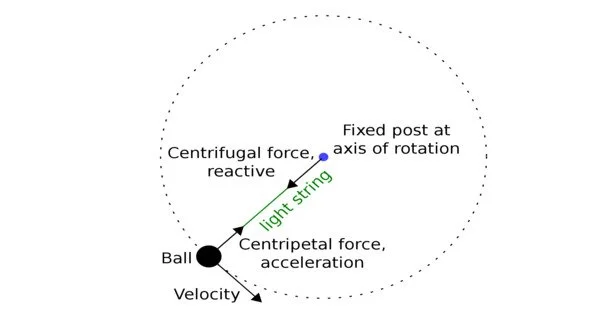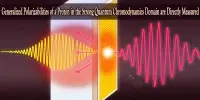Newton’s third law of motion states that for every action, there is an equal and opposite reaction. Centrifugal reaction refers to the equal and opposite reaction to centripetal force, which tends to pull the body away from the center. In fact, the centrifugal reaction is a fictitious or apparent force that acts or is assumed to act as a result of the rotating body’s acceleration.
The centrifugal force is an inertial force (also known as a “fictitious” or “pseudo” force in Newtonian mechanics) that appears to act on all objects when viewed in a rotating frame of reference. It is directed away from an axis parallel to the axis of rotation and passing through the origin of the coordinate system. If the axis of rotation passes through the coordinate system’s origin, the centrifugal force is directed radially outwards from that axis.
In the case of a stone tied to the end of the string is whirled in a circular path, not only the stone is acted upon by a force (centripetal force) along the string towards the centre, but the stone also exerts an equal and opposite force on the hand (centrifugal force) away from the centre, along the string. On releasing the string, the tension disappears and the stone flies off tangentially to the circular path along a straight line as enuciated by Newton’s first law of motion.
The concept of centrifugal force can be applied in rotating devices, such as centrifuges, centrifugal pumps, centrifugal governors, and centrifugal clutches, and in centrifugal railways, planetary orbits and banked curves, when they are analyzed in a rotating coordinate system. Confusingly, the term has sometimes also been used for the reactive centrifugal force, a real inertial-frame-independent Newtonian force that exists as a reaction to a centripetal force.
When a car is turning round a corner, the person sitting inside the car experiences an outward force. It is because of the fact that no centripetal force is supplied by the person. Therefore, to avoid the outward force, the person should exert an inward force.
Centrifugal force is an outward force that is visible in a rotating reference frame. It does not exist when a system is described in terms of an inertial frame of reference. All measurements of position and velocity must be made in relation to some frame of reference. For example, an analysis of the motion of an object in an airliner in flight could be performed relative to the airliner, the Earth’s surface, or even the Sun. An inertial frame is one that is at rest (or moves with no rotation and constant velocity) relative to the “fixed stars.”
An inertial frame can be used to analyze any system (and so with no centrifugal force). However, it is often more convenient to describe a rotating system by using a rotating frame—the calculations are simpler, and descriptions more intuitive. When this choice is made, fictitious forces, including the centrifugal force, arise.
















